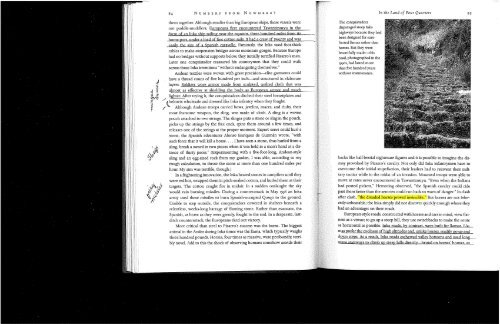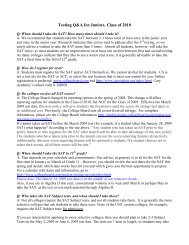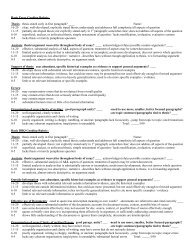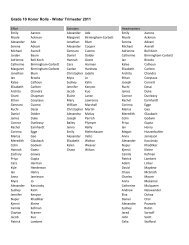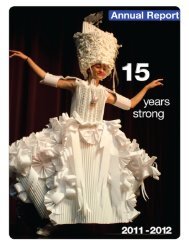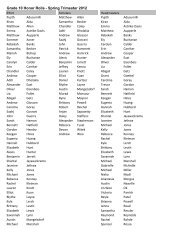CHARLES C. MANN - Cary Academy
CHARLES C. MANN - Cary Academy
CHARLES C. MANN - Cary Academy
- No tags were found...
Create successful ePaper yourself
Turn your PDF publications into a flip-book with our unique Google optimized e-Paper software.
NUMBERS FROM NOWHERE?them together. Although smaller than big European ships, these vessels werenot puddle-muddlers; E.uropeans first encountered Tawantinsuyu in theform of an Inka ship sailing near the eq1lator three hundred mjles from jtshome par" under a load of fine cotton sails. It had a crew of twenty and waseasily the size of a Spanish carayelle, Famously, the Inka used foot-thickcables to make suspension bridges across mountain gorges. Because Europehad no bridges without supports below, they initially terrified Pizarro's men.Later one conquistador reassured his countrymen that they could walkacross these Inka inventions "without endangering themselves."Andean textiles were woven with great precision-elite garments couldhave a thread count of five hundred per inch-and structured in elaboratelayers. Soldlers wore armor made from sculpted, guilted cloth that wasa!glOst as effective at shielding the body as European armor and muchlighter. After trying it, the conquistadors dltched their steel breastplates and/" ~elmets wholesale and dressed like Inka infantry when they fought./ Although Andean troops carried bows, javelins, maces, and clubs, theirmost fearsome weapon, the sling, was made of cloth. A sling is a wovenpouch attached to two strings. The slinger puts a stone or slug in the pouch,picks up the sttings by the free ends, spins them around a few times, andreleases one of the sttings at the proper moment. Expert users could hurl astone, the Spanish adventurer Alonso Enriquez de Guzman wrote, "withsuch force that it will kill a horse .... I have seen a stone, thus hurled from asling, break a sword in two pieces when it was held in a man's hand at a distanceof thirty paces." (Experimenting with a five-foot-long, Andean-stylesling and an egg-Sized rock from my garden, I was able, according to myrough calculation, to throw the stone at more than one hundred miles perhour. My aim was terrible, though.)In a frightening innovation, the Inka heated stones in campfires until theywere red hot, wrapped them in pitch-soaked cotton, and hurled them at theirtargets. The cotton caught fire in midair. In a sudden onslaught the skywould rain burning missiles. During a counterattack in May I536 an Inkaarmy used these missiles to burn Spanish-occupied Qosqo to the ground.Unable to step outside, the conquistadors cowered in shelters beneath arelentless, weeks-long barrage of flaming stone. Rather than evacuate, theSpanish, as brave as they were greedy, fought to the end. In a desperate, lastditchcounterattack, the Europeans eked out victoryMore critical than steel to Pizarro's success was the horse. The biggestanimal in the Andes during Inka times was the llama, which typically weighsthree hundred pounds. Horses, four times as massive, were profoundly, terriblynovel. Add to this the shock of obserVing humans somehow astride theirThe conquistadorsdisparaged steep Inkahighways because they hadbeen designed for surefootedllamas rather thanhorses. But they werebeautifully made-thisroad, photographed in the1990S, had lasted morethan five hundred yearswithout maintenance.In the Land of Four Quartersbacks like half-bestial nightmare figures and it is possible to imagine the dlsmayprovoked by Pizarro's cavalry. Not only did Inka infantrymen have toovercome their initial stupefaction, their leaders had to reinvent their militarytactics while in the midst of an invasion. Mounted troops were ~ble tomove at rates never encountered in Tawantinsuyu. "Even when the Indianshad posted pickets," Hemming observed, "the Spanish cavalry could ridepast them faster than the sentries could run back to warn of danger." In clashafter clash, "the dreaded horses proved invincible." But horses are not inherentlyunbeatable; the Inka simply did not discover qUickly enough where theyhad an advantage: on their roads.European-style roads, constructed with horses and cars in mind, view flatnessas a virtue; to go up a steep hill, they use switchbacks to make the routeas horizontal as possible. J11k,a roads by contrast were huilt for llamas I JamJl!iprefer the coolness of high altitudes and, unlike horses, readily go up anddown steps. As a result, Inka roads eschewed valley bottoms and use.dJQDgstone stairways to climb up steep bms djrect!¥=hrutal on borses' booYe~


